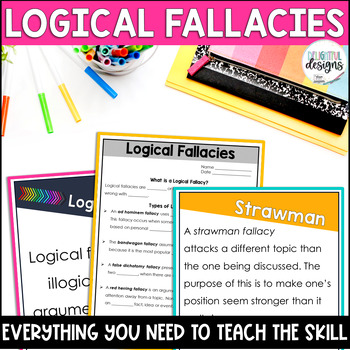Teaching Logical Fallacies Activities | Logical Fallacy Terms Posters
Delightful Designs- Alissa Cook
381 Followers
Grade Levels
8th - 11th
Subjects
Resource Type
Standards
CCSSRI.8.4
CCSSRI.8.8
CCSSRI.8.10
CCSSRI.9-10.4
CCSSRI.9-10.8
Formats Included
- PDF
Pages
20 pages
Delightful Designs- Alissa Cook
381 Followers
What educators are saying
Great addition to my classroom. Students often struggle remembering the academic vocab, so I am glad to have this up on my walls now.
I used this in a gallery walk activity and my students loved it! I also had groups play against each other trying to match the examples to the correct fallacy and they had a ton of fun.
Description
Do you need a fun, engaging resource to teach your students about logical fallacies? This all-inclusive teaching resource is aligned to common core state standards and includes everything you need to teach your middle and high school students about logical fallacies and persuasive devices! This activity can be used to introduce logical fallacy or to supplement your unit plans on informational text comprehension and argumentative writing!
There are 4 important parts to this unit:
- 10 Colorful Posters for introduction of vocabulary terms
- Cloze Notes for student accountability and participation
- Task Cards (with recording sheet) for extended practice and formative assessment
- Teacher Guide and Answer Keys for a no-prep, stress free lesson plan
Logical Fallacies Covered:
- Ad Hominem
- False Dichotomy
- Red Herring
- False Analogy
- Bandwagon
- Strawman
- Appeal to Emotion
- Appeal to Nature
- Circular Reasoning
Follow Delightful Designs for more engaging resources for grades 4-8!
Total Pages
20 pages
Answer Key
Included
Teaching Duration
1 Week
Report this resource to TPT
Reported resources will be reviewed by our team. Report this resource to let us know if this resource violates TPT’s content guidelines.
Standards
to see state-specific standards (only available in the US).
CCSSRI.8.4
Determine the meaning of words and phrases as they are used in a text, including figurative, connotative, and technical meanings; analyze the impact of specific word choices on meaning and tone, including analogies or allusions to other texts.
CCSSRI.8.8
Delineate and evaluate the argument and specific claims in a text, assessing whether the reasoning is sound and the evidence is relevant and sufficient; recognize when irrelevant evidence is introduced.
CCSSRI.8.10
By the end of the year, read and comprehend literary nonfiction at the high end of the grades 6–8 text complexity band independently and proficiently.
CCSSRI.9-10.4
Determine the meaning of words and phrases as they are used in a text, including figurative, connotative, and technical meanings; analyze the cumulative impact of specific word choices on meaning and tone (e.g., how the language of a court opinion differs from that of a newspaper).
CCSSRI.9-10.8
Delineate and evaluate the argument and specific claims in a text, assessing whether the reasoning is valid and the evidence is relevant and sufficient; identify false statements and fallacious reasoning.





